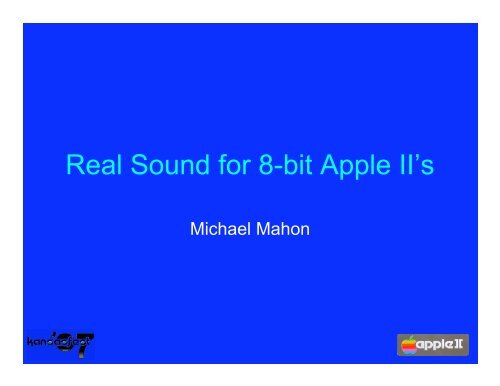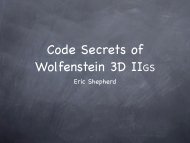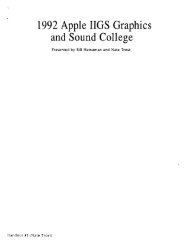Real Sound for 8-bit Apple II's - KansasFest
Real Sound for 8-bit Apple II's - KansasFest
Real Sound for 8-bit Apple II's - KansasFest
Create successful ePaper yourself
Turn your PDF publications into a flip-book with our unique Google optimized e-Paper software.
<strong>Real</strong> <strong>Sound</strong> <strong>for</strong> 8-<strong>bit</strong> <strong>Apple</strong> II’s<br />
Michael Mahon
The <strong>Apple</strong> II speaker<br />
(and cassette output)<br />
<br />
<br />
<br />
Can only toggle “1-<strong>bit</strong> output”<br />
Can’t choose “polarity”<br />
Doesn’t respond to alternate low-frequency toggles
Simple <strong>Sound</strong><br />
<br />
<br />
<br />
Double-frequency timing loop<br />
Squarewaves (beep, etc.)<br />
Actual frequency timing loop<br />
Non-50% duty cycle, timbre (Red Book)<br />
Infinitely-clipped 1-<strong>bit</strong> sound<br />
Distorted speech and music (Hex Dump Reader, Audex,<br />
etc.)
Complex <strong>Sound</strong><br />
<br />
Ultrasonic timing loop with variable duty cycle<br />
pulses<br />
Electric Duet (4 duty cycles = 2-<strong>bit</strong> precision)<br />
Software Automatic Mouth (?)<br />
Sampled sound (many duty cycles)
Variable Duty Cycle<br />
Sample<br />
value<br />
00<br />
7<br />
93 cycles<br />
86<br />
01<br />
8<br />
85<br />
02<br />
9<br />
84<br />
03<br />
10<br />
83<br />
• • •<br />
• • •<br />
63<br />
70 23
Software DACs<br />
<br />
<br />
Sample rate (11.025kHz)<br />
Pulse rate (11.025kHz / 22.05kHz)<br />
Bits of precision (3, 4, 5, 6)
Timing Constraints<br />
<br />
<br />
<br />
<br />
11kHz = 93 <strong>Apple</strong> II cycles/sample<br />
1/93cy = 10.973kHz, -52Hz, -0.005%<br />
1/92cy = 11.092kHz, +67Hz, +0.006%<br />
<strong>Apple</strong> II timing resolution = 1 cycle<br />
4 cycles required to flip speaker<br />
8 cycles per pulse, 4-cycle minimum width<br />
<strong>Sound</strong> amplitude = Δwidth / period
Software DAC loop example<br />
first try: constant 93 cycles, 6-<strong>bit</strong> precision<br />
loop:<br />
4 [Start pulse]<br />
3 JMP vector1<br />
<br />
4 [End 7-70 cycle pulse]<br />
3 JMP vector2<br />
<br />
5 Fetch next sample<br />
2 Check <strong>for</strong> end (if =0)<br />
10 Increment ptr,Y<br />
6 Shift sample<br />
4 Get vector1<br />
4 Set vector1<br />
2 Trans<strong>for</strong>m vector1--> vector2<br />
4 Set vector2<br />
3 JMP loop<br />
117 cycles ** 24 cycles too long! **
DAC611<br />
Constant 93 cycles, 93-cycle pulse period, 6-<strong>bit</strong> precision<br />
loop:<br />
4 [Start pulse]<br />
6 Get vector1<br />
4 Set vector1<br />
3 JMP vector1 (-->long: if >$7F)<br />
<br />
4 [End 19-50 cycle pulse]<br />
4 Trans<strong>for</strong>m vector1-->vector2<br />
4 Set vector2<br />
3 JMP vector2<br />
<br />
10 Increment ptr,y<br />
5 Fetch next sample<br />
2 Test <strong>for</strong> end if =0<br />
6 Shift 3<br />
3 JMP loop<br />
93 cycles<br />
long:<br />
17 (entered at +17 cycles)<br />
<br />
11 Increment ptr,y<br />
4 Trans<strong>for</strong>m vector1-->vector2<br />
4 Set vector2<br />
5 Fetch next sample<br />
2 Test <strong>for</strong> end if =0<br />
6 Shift 3<br />
4 [End 51-82 cycle pulse]<br />
3 JMP vector2<br />
<br />
2 NOP<br />
0 [falls into loop]<br />
93 cycles<br />
[Greg Templeman, 1993]<br />
Pulse frequency of 11kHz is intolerable to many listeners.
DAC522<br />
Constant 92 cycles, 46-cycle pulse period, 5-<strong>bit</strong> precision<br />
<br />
Logically 32 separate pulse generators<br />
Each generates two pulses in 92 cycles<br />
Each fetches next sample and sets vector<br />
Then it vectors to next generator<br />
Computation is distributed between pulse edges<br />
Pulse frequency of 22kHz is inaudible!
DAC522 Pulse Generators<br />
Sample<br />
value<br />
46 cycles<br />
46 cycles<br />
00<br />
6 40<br />
6 40<br />
01<br />
7 39<br />
7 39<br />
02<br />
8 38<br />
8 38<br />
03<br />
9 37<br />
9 37<br />
• • •<br />
• • •<br />
• • •<br />
31<br />
37 9<br />
37 9
Other Problems<br />
<br />
<br />
Starting and stopping without “pops”<br />
Solution: Don’t stop!<br />
• “Ramp” waves to start and stop at 0 level<br />
• generate continuous 0-level pulses (except <strong>for</strong> key clicks)<br />
Generating long sounds at 11kB/second<br />
Solution: Direct Digital Synthesis<br />
• Resample wavetables on-the-fly<br />
• Use envelope table <strong>for</strong> dynamics
RT.SYNTH<br />
Single-voice multi-timbral real-time wavetable synthesizer<br />
<br />
<br />
<br />
<br />
Voice waves are resampled on-the-fly to note frequencies<br />
Frequency = Integer.fraction sample index increment<br />
Can support as many different voices as fit in memory<br />
<br />
<br />
A voice is represented as a set of single-cycle waveshapes selected by a<br />
table representing the envelope of the voice.<br />
This supports<br />
• Tonal voices with complex attacks that are resampled<br />
• Atonal sounds that are played as “waves”<br />
Wavetable wave<strong>for</strong>ms are stored starting and ending at zero<br />
amplitude to minimize pops<br />
“Resting” or idling sound is the zero-level pulse train
DAC522 Generator Code<br />
0800: 8D 30 C0 >6 gen0 sta spkr ; 7 nop ; Kill 2 cycles<br />
0804: 8D 30 C0 >8 sta spkr ; 9 sta ztrash ; Kill 3 cycles<br />
0809: E6 ED >10 inc scount ; Compute envelope<br />
>11 ciny<br />
080B: F0 01 >11 beq *+3 ; If =, branch to iny<br />
080D: A5 >11 dfb $A5 ; "lda $C8" to skip iny<br />
080E: C8 >11 iny<br />
>11 eom<br />
080F: 18 >12 clc<br />
0810: A5 EC >13 lda frac ; Compute next sample<br />
0812: 65 FE >14 adc freq<br />
0814: 85 EC >15 sta frac<br />
0816: 8A >16 txa<br />
0817: 65 FF >17 adc freq+1<br />
0819: AA >18 tax<br />
081A: B1 06 >19 lda (env),y ; Next sample page<br />
081C: 8D 30 C0 >20 sta spkr ; 21 nop ; Kill 2 cycles<br />
0820: 8D 30 C0 >22 sta spkr ; 23 sta ztrash ; Kill 3 cycles<br />
0825: 8D 2A 08 >24 sta :ptr+2<br />
0828: BD 00 00 >25 :ptr ldaa 0*0,x ; Fetch sample.<br />
082B: 8D 3C 08 >26 sta :sw0+2<br />
082E: C6 FC >27 dec dur ; Decrement duration<br />
>28 cdec dur+1<br />
0830: F0 02 >28 beq *+4 ; If eq, branch to dec<br />
0832: EA >28 nop ; Else kill 2 cycles and<br />
0833: AD >28 dfb $AD ; "lda xxxx" to skip dec<br />
0834: C6 FD >28 dec dur+1 ; of zero-page param.<br />
>28 eom<br />
0836: A5 FD >29 lda dur+1<br />
0838: F0 03 >30 beq :quit ; Finished.<br />
083A: 4C 00 00 >31 :sw0 jmp 0*0 ; Switch to gen, T = 89<br />
>32<br />
083D: 4C 40 09 >33 :quit jmp quit
CRATE.SYNTH<br />
8-voice multi-timbral MIDI playback wavetable synthesizer<br />
<br />
<br />
<br />
Uses <strong>Apple</strong>Crate machines as eight digital oscillators<br />
MIDI.COMPILER<br />
Merges multi-stream MIDI events<br />
Tempo changes complicate timekeeping<br />
Schedules 8 digital oscillators in one pass<br />
Tries to re-use oscillators with a voice history<br />
When >8 oscillators needed, “steals” from oldest note<br />
CRATE.SYNTH<br />
Uses NadaNet to load the 8 oscillator machines<br />
Starts them all in sync (<strong>Apple</strong>Crate drift is ~1 ms. in 40 sec.)
Questions and discussion...






![Converting Apple][ NTSC to VGA - KansasFest](https://img.yumpu.com/23761475/1/190x143/converting-apple-ntsc-to-vga-kansasfest.jpg?quality=85)

